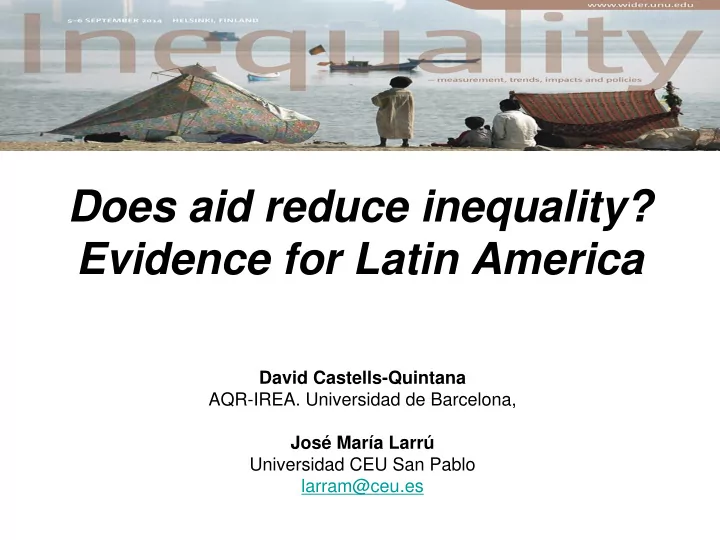

Does aid reduce inequality? Evidence for Latin America David Castells-Quintana AQR-IREA. Universidad de Barcelona, José María Larrú Universidad CEU San Pablo larram@ceu.es
MOTIVATION & FRAMEWORK POVERTY within - + income between +/-? INEQUALITY GROWTH outcomes / opportunities ? + ?? AID
OUTLINE • INEQUALITY IN LATAM: LIT. REVIEW • AID AS POSSIBLE DETERMINANT OF INEQUALITY – Lit. review – Theoretical channels • EMPIRICAL EVIDENCE – Data and trends (Gini and AID/GDP) – Correlation analysis – Cross-country evidence • Cross-section and pooled • Panel data: – pooled OLS (triennial data) – -System-GMM (triennial & annual data) • CONCLUSIONS
INEQUALITY in LATAM Average Gini 1990-2008 70 60 58,27 56,36 56,06 55,80 55,66 55,36 55,25 55,24 54,29 53,24 52,60 52,25 50,60 50,55 49,90 48,36 50 46,71 44,88 43,95 40 ini G 30 20 10 0 a s a 8 r . a a y a a y r á a l e o u o p i o a u 1 l a i m n c l a z i a b r d e v d l c e u r i g - e i u a m m h a i R u i u i M R t g a a x n r l a P g o d C v z B n é e a o u r A e u B a e n a a M l . c a m t r l T g r a o t n a E o P c S s U r C A e u P H i o A o N G L l D V C E Lower Middle Income Countries in yellow
Changes in Inequality: 1990-2008 8,00 6,98 6,00 4,71 4,00 2,69 2,33 1,81 2,00 G in i p ercen tag e p o in ts 1,11 0,63 0,39 0,00 0,00 ECU PER ARG ELS VEN PAR BRA PAN BOL MEX NIC GTM CHI HON URU RDOM CRIC COL -1,22 -1,30 -2,00 -1,66 -2,33 -2,36 -2,92 -2,95 -3,19 -3,24 -3,33 -4,00 -3,51 -3,86 -4,06 -4,20 -4,51 -4,56 -6,00 -5,77 -6,16 -6,16 -6,24 -6,43 -6,63 -6,90 -6,24 -7,32 -8,00 -8,51 -8,66 -10,00 2008-1990 2008-max
CAUSES • Macro-policies – Trade openess • Fiscal policy – Progressive taxation – Condional cash tranfers (focused) • Lower skilled labour premium – Increase average years of schooling – Employment for low-skilled workers ( maquiladoras) – Higher minimum wages • External flows – FDI & remittances
OUR SAMPLE
AID in LATAM
DATA for OUR SAMPLE
LIT. REVIEW • POSITIVE: – Bornschier et al. 1978; Layton & Nielson 2008; BjØrnskov 2010 – Herzer & Nunnenkamp 2012 (cointegration) • No effect: – Dolan & Tomlin 1980; Chong et al. 2009 (N=112 T=1972-2001) • NEGATIVE: – Cuesta et al. 2006; Tezanos et al. 2013
AID & INEQUALITY: CHANNELS AID MULTI ‐ BI ‐ LATERAL BILATERAL MULTILATERAL (pooled & common funds) NGOs agents Central state Non ‐ central state Budget support Debt relief Technichal assistance Projects & programmes instruments Fiscal policy (budget constraint) Macro ‐ stability SOCIAL ECONOMIC INFRASTRUCTURE PRODUCTION MULTISECTOR sectors education health climate investment food and micro humanitarian aid water and sanitation businesses Programs & projects In ‐ kind transfers Cash transfers Credits Knowledge & know ‐ how Policies and elite middle class poorest political context Political reforms (voice, participation, civil rights, security, better democracy and institutions) income poverty INCOME DISTRBUTION
SELECTED CHANNELS • Focus on the poorest zones, groups, sectors • Better governance: trade unions -> minimum wages, collective negotiations… • Macro-stability: multilateral programmes – Lower inflation – Better real exchange rate & terms of trade – Attract FDI • Debt relief frees-up resources • Direct Budget Support (CCTs programmes) • Technical cooperation (fiscal reforms)
By country: 8 cases <0 URU=-5.1 CORRELATION (R 2 =0.45) Brazil ≈ 0 9 cases >0 ECU=+6.4 (R 2 =0.46)
OUR MODEL • CONTROLS: – Chong et al. (2009) : • inflation; liquid liabilities; literacy; GDPpc; agriculture and industry (%V.A.) – Domestic redistributive policies: • Public expenditure (and social exp.) – Labour institutions and education • Minimum wages (formal); unemployment; Gini-education – External redistributive flows: • Terms of trade; FDI; remittances – Political context: • polity 2
CORRELATION MATRIX
RESULTS: cross-section
Results: pooled cross-section
Results: SYS-GMM
ROBUSTNESS • Gini: – 2008 vs average – SEDLAC: Gini, Theil, Atkinson, E(0) but 230 observations vs our 323 (correlation=0.992) • Aid – Per capita vs ODA/GDP(%) – Gross disbursements (with & without debt relief)
CONCLUSION • Consider aid as an egalitarian external flow • Multiple channels: types, donors, instruments, sectors. • Complex transmissions • Caveats: – Measurement erros (Gini annual) – Overall effect vs. Country specific effect
Recommend
More recommend